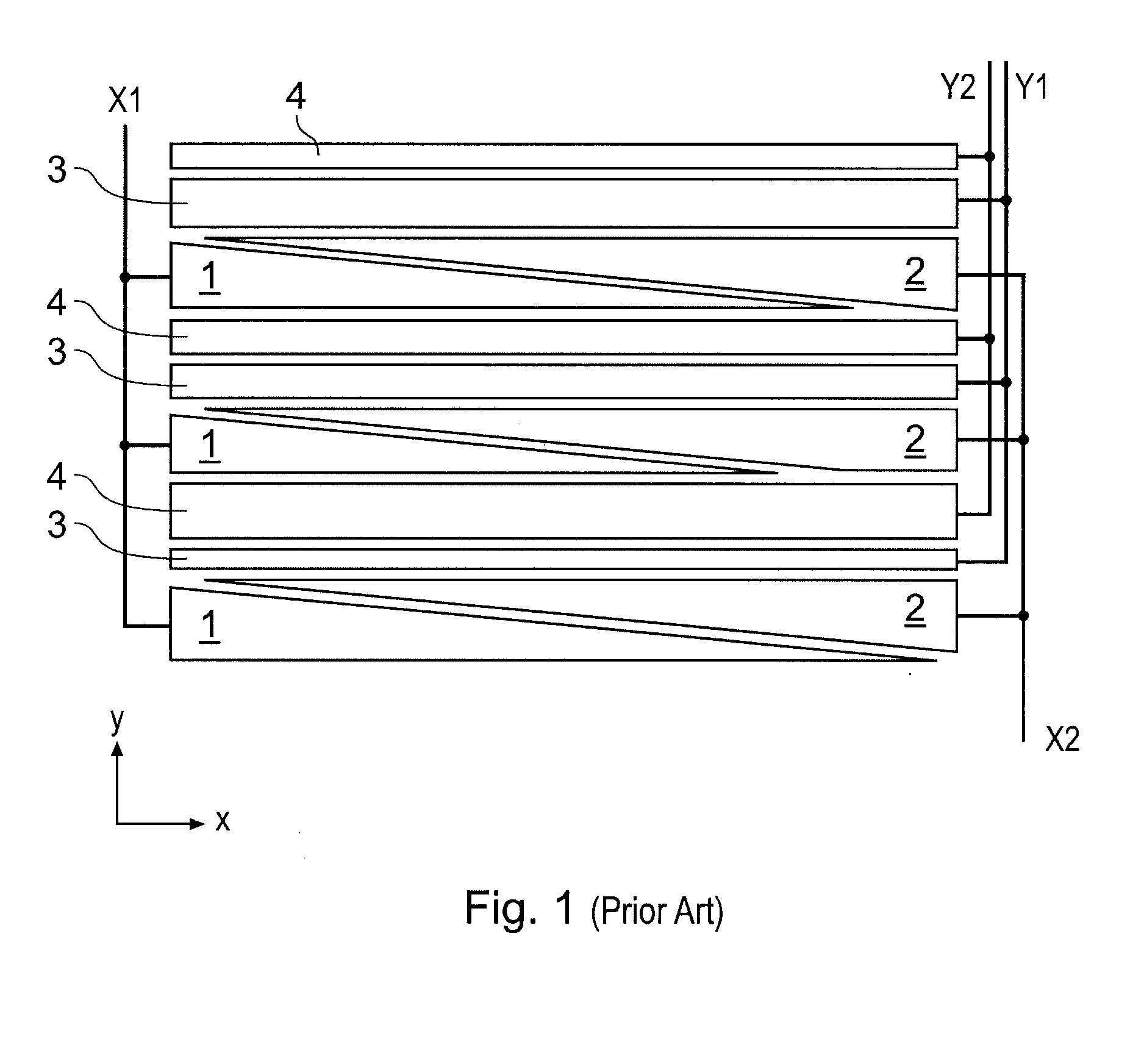Two Dimensional Position Sensor
a capacitive position and sensor technology, applied in the direction of instruments, electric digital data processing, input/output process of data processing, etc., can solve the problem of becoming impractical to add further groups of x-electrodes
- Summary
- Abstract
- Description
- Claims
- Application Information
AI Technical Summary
Benefits of technology
Problems solved by technology
Method used
Image
Examples
first embodiment
[0069]FIG. 2 is a schematic plan view showing representative parts of an electrode pattern for a 2DCT of a first embodiment, wherein the electrode pattern define a sensitive area for the device. The electrodes are arranged on a substrate which is not expressly shown, but which has an upper surface lying in the plane of the paper. The substrate may conveniently be a flexible transparent plastics material such as polyethylene terephthalate (PET). The substrate will generally be insulating. The electrode pattern is made of indium tin oxide (ITO) having a resistivity of a few hundred ohm / square. This is a transparent material and thus suitable for display applications, or other applications where an underlying button or other template needs to be visible. More generally, the electrode pattern can be made by depositing or removing any suitable conductive material. Deposition can be by vapor deposition or screen printing, for example. Removal can be by laser or chemical etching, for examp...
second embodiment
[0094]In general there must be a minimum of two such external connections in the second embodiment which form end connections of the slider. These end connections should preferably be connected to the top-most and bottom-most y-electrode, or at least ones near the top and bottom. It is also beneficial to provide one or more additional external connections between these two end connections to improve y-position sensing accuracy by effectively forming multiple sliders along the y direction. Usually there will be a desire imposed by cost to limit the number of external connections to a fixed number, in which case as many y-electrode external connections can be provided as there are spare external lines after allocation of sufficient lines for the x-electrodes.
[0095]FIG. 7 is a schematic plan view similar to FIG. 6 showing parts of an electrode pattern and y-connections for a variant of the second embodiment. The y-electrode bars 10 and external connection lines 52′-60′ serve the same f...
fifth embodiment
[0108]FIG. 14 is a schematic plan view showing a part of an electrode pattern for a The pattern here differs from those of the previous embodiments in that the shape of the double-taper x-electrodes 16′ are inverted from a “stork bill” to a “bow tie” shape in which the taper is towards the middle of the double taper instead of away from the middle. This double-taper shape is shown with reference to an embodiment with a spine 26′ although it could also be used in spineless designs. The single taper x-electrodes 14′, 18′ are correspondingly inverted to form the necessary co-extension with the bowtie double taper electrode 16′.
[0109]FIG. 15 is a schematic plan view showing parts of an electrode pattern for a sixth embodiment. This embodiment can be understood by comparison with the first embodiment illustrated in FIG. 2. As in the first embodiment, the sensing area is divided into left and right halves by a central spine 26″. The y-sensing is performed by left and right side y-electro...
PUM
 Login to View More
Login to View More Abstract
Description
Claims
Application Information
 Login to View More
Login to View More - R&D
- Intellectual Property
- Life Sciences
- Materials
- Tech Scout
- Unparalleled Data Quality
- Higher Quality Content
- 60% Fewer Hallucinations
Browse by: Latest US Patents, China's latest patents, Technical Efficacy Thesaurus, Application Domain, Technology Topic, Popular Technical Reports.
© 2025 PatSnap. All rights reserved.Legal|Privacy policy|Modern Slavery Act Transparency Statement|Sitemap|About US| Contact US: help@patsnap.com



